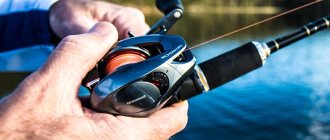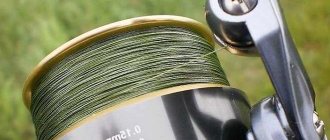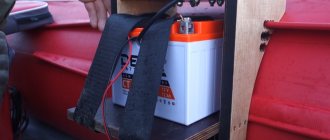Multiplier reels appeared on the domestic fishing market relatively recently, but have already managed to raise a whole bunch of questions and problems among fishermen. Unprepared fishermen buy a multicast and after arriving at a pond they cannot cast it or set it up correctly.
To prevent this from happening to you, we recommend that you study all the nuances of selecting and setting up a coil, but before that you should understand its true purpose and understand whether you really need this type of coil.
How to set up a baitcasting reel?
For comfortable fishing, you will have to tinker a little with the correct reel settings. Despite the complexity of the mechanism, it is quite simple to set up. But for proper preparation, you will need to know the basics and allocate some time for this process.
It is most convenient to set up a mechanical brake system on a pond
.
- First you need to hook the bait you are using to the leader or fishing line.
- After this, place the spinning rod at an angle of 90 degrees to the shore.
- Release the bait and watch the spool as the bait hits the ground.
- If the bait fell to the ground and the reel then made one or half a revolution, then the brake is set as it should.
- If this is not the case, then tighten or loosen the mechanism to achieve this result.
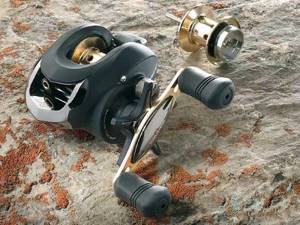
Setting up a centrifugal or magnetic brake is more difficult
than mechanical. This is where everyone’s unloved trial and error method comes into force, which is called empirical.
- If you notice obstacles to the flight of the bait, then you need to loosen the brake.
- If you notice dashing, tighten the brakes.
Experienced fishermen can use baitcasting reels without using a brake. This is done to increase the casting distance of the bait. Fishermen remove both drag mechanisms from the reel, and some even remove the line guide. Such tackle can only be controlled in one way - with the help of your fingers.
By dismantling the line layer, the casting range actually increases. But it is very difficult to control such gear, so beginners should not experiment.
How to cast a cartoon?
If you do not know how to properly cast a spinning rod with a multiplier, then even the most advanced braking system will not save you from the formation of a beard from the fishing line. There are many ways to learn casting techniques; the most effective are watching videos and observing more experienced fishermen; an alternative is studying text information.
You need to remember one very important nuance - such tackle is never thrown from behind the head
. First, novice fishermen are advised to carefully study the side casting technique. Switch the reel to casting mode, hold your finger on the multiplier spool and try to cast. The finger must be removed at the moment the line begins to come off the reel.
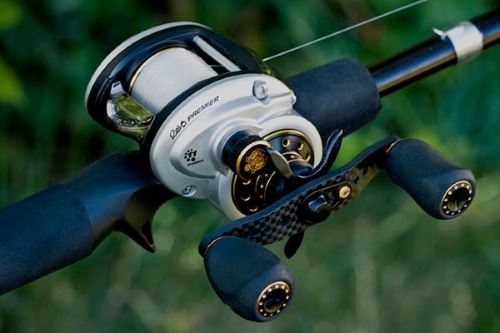
The first casts usually don’t have a particularly long range, but you shouldn’t even count on that. It is much more important to ensure that the hook does not catch on clothing or create a beard. Pay special attention to the placement of your finger on the spool and control the line coming off. The line should come off easily, but not spontaneously, control this.
Try to train in complete absence of wind. You must cast the tackle so that the spinning rod is positioned along the flight path of the bait, and the fishing line lies in as straight a line as possible.
Some fishermen who relatively recently switched from a spinning reel to a multiplier reel try to be guided by previously accumulated experience and adapt it to casting new gear. Here it’s the other way around - sudden jerks can lead to big problems, all movements should be carried out as smoothly as possible
.
Features of such coils
The inertia of the reels is greatly reduced due to the use of a small diameter axis and replaceable weights. Magnetic braking system
provide complete control over the braking process while the bait falls into the water. But the mechanisms are still not perfect, and to avoid the formation of a beard, fishermen still must control the rotation of the reel with their finger. Experienced fishermen exercise this control on a subconscious level.
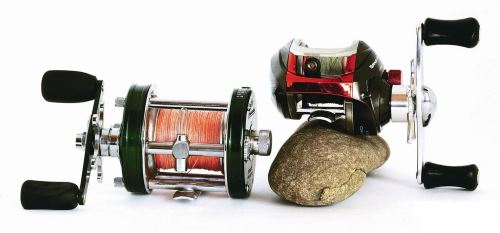
Gear transmission
, used in coils of a similar design, is installed on them for a reason. This technical feature allows for a very high speed of winding the line onto the spool. Comparing multiplier reels with spinning reels, with the same spool diameters, one revolution of the multiplier is equal to 3 or 4 revolutions of conventional reels.
But over the many years of operation of these mechanisms, fishermen have managed to note not only the positive aspects of such reels. These mechanisms also have some disadvantages
.
Fishing using light weight lures is not very comfortable
. Experienced fishermen claim that a multiplier reel for a spinning rod intended for fishing with baits weighing up to 9 grams is simply unacceptable. Most often, such reels are used for catching very large fish with bulky and heavy gear.
The presence of a braking system requires constant adjustment
. The multiplier brake is adjusted individually each time for certain fishing conditions and different baits. Regardless of the type of brake system, it will still have to be adjusted; we described the correct setting above.
Criterias of choice
Every fishing fan has a desire to purchase a baitcasting reel. But if we are talking about choosing the first working tool for a beginner, then it is much more reasonable to give preference to a more affordable inertia-free model, since it is not difficult to understand the principle of its operation, but multipliers need a special approach and careful configuration. Only after acquiring basic skills can you move on to such serious tools.
In order for the choice made to meet all expectations, it is necessary to take into account some subtleties and tips:
- Under no circumstances should you prioritize a low price and skimp on important performance properties. A baitcasting reel is a professional fishing device that must be manufactured using high-tech processes with maximum precision and adjustment of individual components. And for a good product you need to pay “good” money, so you need to be prepared for such circumstances. Chinese analogues do not cope well with their responsibilities, and their service life directly depends on the load.
- Before you pay for the model you are interested in, you should look at its passport. Such a document indicates the main operating parameters, for example, the permissible diameter of the fishing line and the recommended weight of lures. If you follow the basic rules specified in the passport, the service life of the product increases, and, accordingly, the comfort of fishing.
- If we are talking about fishing in Russian reservoirs with limited space, then for better accuracy and casting range it is advisable to use multiplier reels with small dimensions and a “soap” setting. Low inertia and a fixed hole line guide ensure productive line reeling with minimal risk of beard formation. The selected model should be equipped with a ceramic eye, since other materials contribute to rapid chafing of the cord. In the case of monofilament or fluorocarbon products, there is no such nuisance.
- If the emphasis is on making long casts, it is better to give preference to “soap boxes”. Due to the low profile setting, line bending will be minimal and friction will be reduced.
Is it possible to install a baitcasting reel on a regular spinning rod?

Many fishermen ask this question. When purchasing a multiplier, they do not think about the compatibility of such mechanisms with conventional models of fishing rods. This is the most common mistake many beginners make.
to install a baitcasting reel on a regular spinning rod , but it is not recommended
. On classic spinning rods a small number of rings are installed, but for proper functioning there must be more of them.
You will need to buy a special casting spinning rod
. You can try to remake the classic blank and try to adapt it to install such a reel, but as practice shows, this will lead to a significant reduction in casting range.
To watch online, click on the video ⤵
Casting with a multiplier reel. Setting up the baitcasting reel Learn more
How to wind a line on a baitcasting reel. More details
Multiplier tackle. Settings. Casting technique Read more
Demonstration of the capabilities of the Shimano Antares DC7 baitcasting reel More details
NO BEARD! Setting up the baitcasting reel Learn more
A baitcasting reel for a beginner. First casts Read more
Casting tackle - setting up the baitcasting reel and making your first casts! Cartoon in the hands of a beginner Read more
Casting with a multiplier reel - Skipping - how to do it! More details
Multiplier tackle for beginners. Part 2. How to set up a coil. More details
Learning to Throw with Casting Tackles. How to Set Up a Multiplier Reel. More details
How to set up a baitcasting reel. How To Adjust A Baitcasting Reel Learn More
Review of the Kastking Spartacus baitcasting reel from Aliexpress Read more
Disadvantages of baitcasting reels Read more
How to learn to throw with cartoons! More details
WASTED YOUR MONEY?! Seaknight falcon cast baitcasting reel More details
Multiplier reel jamb. And how to fix it. More details
TOP 5 Tips for beginners. 5 LIFE HACKS. Including how to adjust the multiplier reel clutch Read more
How to properly make “Beards” while FISHING. Mastering casting. More details
Types of coils
The popularization of multipliers has led to the spread of a huge number of improvements and modifications for such designs. Fishermen usually use the generally accepted classification into 2 types of reels:
- Barrels;
- Soap dishes.
Barrels

Our anglers prefer these types of reels, and they are the most popular. They have become popular among domestic fishermen because they are easy to use and relatively reliable. The power of such reels is relatively large, as are their dimensions, which allows the use of large baits and thick fishing line for fishing for large fish.
This type of reel got its name for a reason. The shape of such reels is very similar to barrels. This design makes it easy to carry large baits and troll for large fish without harming the rotation mechanism itself.
Often, such models are used for fishing with large jig baits (weighing about 70 grams), or when using large wobblers.
Classic spinning reels are not suitable for fishing with such gear - they will simply fail prematurely. If you need a stable, reliable and traction reel, then choosing this type would be the best option.
Soap dishes

These reel models are designed for medium loads. Their feature is the small bend angle of the fishing line. This design feature allows you to significantly simplify the process of casting and releasing line from the spool.
With such a reel you can cast your usual baits over a long distance. As a rule, lightweight alloys of various metals are used for the manufacture of mechanisms, ensuring low weight and ease of casting.
But the use of such reels does not mean that you are prohibited from fishing using large and heavy baits. Regardless of the type, all baitcasting reels are very durable and reliable. In isolated cases, the use of such reels for fishing with bait weighing about 50 grams is permitted.
Slowing down is important
While the bait is in flight, the casting is not yet completed. Before the bait lands on the water surface, the spool should be slightly braked with your thumb.
If this is not done, the line may “run over” and a “beard” may form. The bait dropped into the water, the line did not get tangled, but you are unhappy with the casting distance or accuracy.
In this case, I have a technique that will help ensure the necessary accuracy on crucial meters.
A line that is loose when swinging will not allow you to get the required casting distance. Therefore, before casting, the bait should hang 30–50 cm from the tip of the rod. Only in this case will the line always be taut during the swing.
The reason for an inaccurate and short cast may also be a thick, coarse fishing line. Because it doesn't come off the spool well.
When predominantly monofilament lines were used to catch predatory fish, this was a real problem. I had to use a fishing line of relatively large diameter. To extract large and strong fish from the water.
Today, most spinning anglers rely on braided fishing lines. Which, with a smaller diameter, have a high breaking load.
For heavy spinning fishing, a braided line with a diameter of 0.25–0.3 mm is suitable. For medium to light fishing I use 0.2mm braided line. And for ultra-lightweight, braided fishing line with a diameter of 0.12–0.15 mm is sufficient.
With such fishing lines you can make perfect casting.
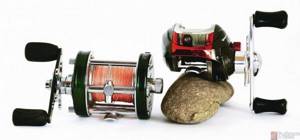
Rating of popular manufacturers
This type of reel is not very popular, but many world leaders in the fishing market are engaged in their production. The choice of multiplier type reels is very large - you can find high-quality budget models, or you can choose an expensive and elite reel. Fishermen have tried many reels and note the following manufacturers:
- Abu Garcia;
- Daiwa;
- Banax;
- Shimano;
- Penninternational.
Abu Garcia

Abu Garcia is considered one of the leading companies in this segment. The company produces reels for casting fishing and sea fishing. The company's products are particularly reliable, powerful and low priced.
The company was founded in 1921 and is still operating today. The Swedish company accounts for about half of all fishing products produced. The Ambassador model turned out to be the best reel produced by the company. Over the years, many different modifications of this model have appeared.
Daiwa
The well-known company Daiwa, located in Japan, is in great demand in the fishing goods market. It is officially believed that the company was founded in 1945. Daiwa produces a whole series of popular reels.
Multiplier reels Millionaire and TD-Luna are extremely popular among domestic fishermen. And the Bayard, Steez and Smak models are noted by many experienced fishermen in other countries. These reels belong to the middle price class.
Banax

In 1973, a company was founded in Korea that competes with world leaders in the production of fishing equipment. It was Banax. At first it did not exist separately, but was a branch of Daiwa, but in 1996 it separated.
High quality, low price, large selection and reliability - these are the main qualities that fishermen note in the products of this company. Reels are no exception to the rule and they are very popular among fishermen.
Shimano
Shimano is a legendary company. The Japanese company is considered the most technologically advanced and always remains one step ahead of its competitors. At the first stages of the company’s operation, it focused on bicycle parts, but then directed its vector to the fishing market.
We can talk about this company endlessly. A legendary fact for the company was the record for bait casting distance achieved using the Aero model from the Japanese. The price of coils from this company is relatively high.
Penn international

Penn international is an American company that also occupies a leading position in the fishing goods market. The main aspect of the company is set on baitcasting reels and fishing rods.
A special feature of reels from Penn international is the ability to choose among expensive and budget models, and not all companies can afford this. All reels are durable and reliable when used and cared for properly.
Review of popular models
Of course, Abu Garcia, which produces reels for both sea fishing and casting fishing, is considered the recognized leader among multipliers. They are reliable, practical and have an affordable price.
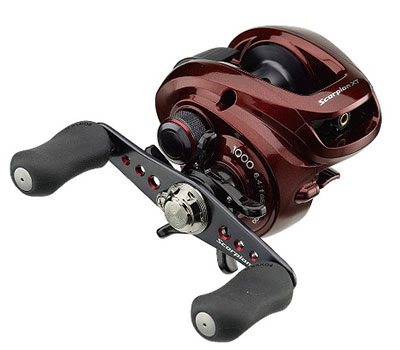
Multiplier Reel "Daiwa"
The Daiwa multiplier reel is famous for its innovative developments. Polish “Salmo”, Chinese “Kosadaka” and “Siweida” produce budget models suitable for the initial stages of learning casting fishing.
Each manufacturer has models that are worth noting so that beginners can navigate when choosing a cartoon.
AbuGarcia Ambassadeur BCX
A classic inexpensive bait that can be used in many types of fishing. Most often, this reel can be seen in jerk fishing, heavy jigging, twitching large minnow wobblers and, of course, lake and river trolling.
This multiplier is popular due to its low cost and decent performance. The reliability and durability of the reel cannot be doubted, and its power will compete with products from the more expensive segment.
AbuGarcia Ambassadeur Orra
Low profile mid-price reel. Suitable for both beginners in casting fishing and more advanced spinning anglers. It has a durable body, compact dimensions, and lays the line well. This multiplier can be used in twitching, jigging, jerk fishing and swimbait fishing.
AbuGarcia Ambassadeur Revo PremierHS
One of the smallest and lightest multis that can be caught with lures weighing up to 15 grams. Can be used in jigging and twitching. The reel is very compact and easy to use. The body and other elements of the multiplier are strong and durable. Allows the use of thin fishing line, which is laid very evenly without dips or “humps”.
Daiwa Steez
This reel is recognized as the lightest in its class. Refers to elite multiplier reels. It is chosen by professional athletes and advanced spinners. It was originally developed for bass fishing, but has found application in jigging and twitching. It has a durable lightweight body, ideal line laying, sufficient power and unsurpassed reliability.
Banax Zest
Budget multiplier from a well-known manufacturer. The Banax Zest baitcasting reel perfectly combines versatility, sensitivity and reliability. Can be used for fishing with heavy and medium spinning rods with lures from 25–30 grams. Perfect for beginners for their first steps in casting fishing.
And here's what you need to know: Selecting and winding the cord for the feeder
Kosadaka Atlas
This is an inexpensive reel, adapted for trolling fishing and deep sea fishing. The cartoon is equipped with a counter that allows you to determine the distance to the bait. Like all Chinese Kosadaka reels, it has good strength characteristics, fairly accurate settings and a reliable drag. With such a cartoon you can catch trophy fish. Not suitable for casting fishing.
- "AbuGarcia";
- "Daiwa"
- Banax;
- "Kosadaka"
- Shimano;
- "Salmo"
- "Siweida".
How to choose MK?
The size of the spool and the power capabilities of the reel are far from the main parameters that you should pay attention to when choosing a reel. The choice of a particular model is influenced by many factors and all of them must be taken into account.
Housing material
Modern technologies have made it possible to achieve the integration of metal alloys and plastics. The reel body can be completely metal or combined with plastic. Plastic
allows you to make the reel lighter, but has a negative impact on its durability.
Metal reels
are very reliable and have a long service life, but they are afraid of physical impact - shocks.
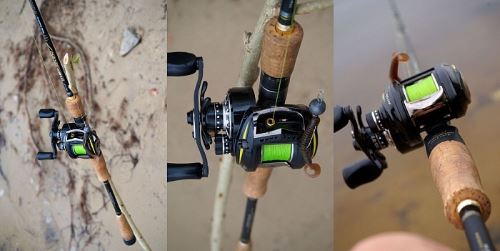
Brake design
The braking design of multipliers is very complex and it is fundamentally different from other types of reels. As a rule, it is precisely because of the braking system that novice fishermen cannot use such reels normally. To set it up correctly, you must understand how the brake mechanism works.
During casting, the reel spool rotates under the weight of the flying bait. When the bait touches the water, the forces transmitted by the line to the reel are significantly reduced, but under the influence of inertia the reel continues to rotate. The braking system begins to work at the moment the cast begins, and then comes into effect at the final stage
.
Modern reels use centrifugal or magnetic braking systems. Centrifugal system
works due to the movement of weights due to centrifugal force in the direction of a special partition and subsequent friction against it.
The magnetic system
works on the principle of braking the spool due to magnets.
Left and right rotation
Unlike conventional spinning reels, it is not possible to move the handle to the other side in a multiplier reel. Therefore, you should immediately pay attention to this nuance and give preference to a model tailored to your hand.
fishing line
For any reel model, the recommended diameter of the fishing line used is indicated, so you should pay special attention to this parameter. If you install a cord of a larger diameter on the reel, there is a high risk of breaking the braking system. And by installing a fishing line of a smaller diameter, you run the risk of breaking during casting, as it can slip into the gap between the body and the spool.
Availability of a line laying machine
The advantages of a line layer are known to all fishermen - it allows you to evenly lay the line on the spool. Its presence completely eliminates the presence of humps and holes on the spool. But multipliers are designed in such a way that the line rubs against it during casting, which significantly reduces the flight range of the bait. It is best to pay attention to the presence of a function to turn off the line guide before casting.
Sensitivity to bobbin lock
A spool locking mechanism is present on any reel and it prevents the reel from spinning spontaneously. This blocking should be installed when landing fish and removed while casting the bait. The reels are equipped with a special switch that is designed to protect against line breakage when the lock is on.
Other aspects
As a rule, baitcasting reels are purchased when fishing for trophy fish is planned. Fishing for large fish places enormous stress on all reel components. Most often, bearings wear out. To increase the life of bearings, they must be lubricated. Branded reels are equipped with bearing grease.
Casting control systems for multiplier reels. A look back. Part 1. Magnetic systems.
Since I sell spinning reels from the second half of the nineties and the beginning of the two thousandths, I constantly have to prove that these tackles are still relevant and in most cases are not inferior to modern ones, and in terms of strength and durability, they are usually superior to the “remake”.
On this occasion, you have to write articles, conduct tests and small studies. Sometimes it happens to enter into controversy on fishing forums. And the main argument of my opponents on the forums is the argument that progress does not stand still, and if Daiwa, ABU and Shimano have a staff of engineers, then what else can they do if they improve the gear and thereby move progress forward.
Well, I’m not a retrograde person either, and I’m optimistic about progress. However, due to the nature of my work and my long-standing passion for this topic, I am often more informed about changes in fishing gear than my opponents. And as you know, a well-informed optimist is most likely already a pessimist.
And I will try to justify my pessimism about the rapidly improving gear. And as a justification, I will give a short review. This review is rather frivolous and does not pretend to be a serious study. I just have a small collection of old cartoons, and this time I wanted to use them as an example to consider the evolution of braking systems. No deep digging into the details, a little history and a direct visual comparison of what was and what became. Not more.
Let's start with the so-called linear magnetic system .
Pictured here are two systems, MagTrax™ and AutoMag™, from Abu Garcia . These systems are essentially twins. The same magnets on a spring-loaded bar, which can be moved closer or further away from the spool using a regulator. Of course, AutoMag looks a little more fundamental than its younger brother, but those were the times back then - there were more resources on the planet and they didn’t skimp on little things.
Auto M ag is about thirty years older than its brother. The picture shows an Abu Garcia XLT 1 SYNCRO equipped with such a system. It was produced in the first half of the eighties.
For example, reels such as the Abu Garcia Black Max , Abu Garcia Silver Max , etc. are MagTrax™ system
If we take into account that the more modern system of linear magnetic brakes MagTrax II™ ( ABU Garcia Revo Big Shooter Compact ) is not fundamentally different (there is a hypothesis that the difference is only in the name) from MagTrax ™ , then it turns out that this system is already almost 35 years!!!
This may upset someone, because for the umpteenth time they buy a new reel, believing that it is more advanced than the old one, but not me. I know that since the system has existed for so many years, it means it is good and reliable. By the way, this brake system was used in the legendary ABU Garcia Mörrum SX MAG . For me this is a strong argument in its favor.
Abu Garcia has another magnet system - UltraMag ™, once in the 2000s it was used in several models of elite Abu Garcia Mörrum Ultra Mag . Unlike the previous ones, this system is already non-linear. The panel with magnets in it is movable and changes its position relative to the spool depending on the rotation speed. Of course, UltraMag ™ can be considered a more modern system than the previous ones. It is possible, if not for one thing, but. The fact is that in 1982 Abu had a reel with the same system and even the name ABU Garcia Ambassadeur ULTRA MAG XL.
Now about another magnetic system. Its main difference from the previous one is that the spool has a special inductor. Here the inductor directly interacts with the magnets, and not the sidewall of the spool. It rotates between two rings, which may themselves be made of magnets, or may simply carry several magnets on themselves. The adjustment occurs by changing the position of the rings relative to each other.
In most cases, we call this cast control system Magforce . Under this proper name she exists in the Daiwa cartoon program. Ryobi called this system simply Ryobi Magnet Brake System .
This system is no less ancient than ABU Garcia AutoMag . In the following images you can see the Daiwa Super Millionaire ST- 15 This is about the same era as the Abu Garcia XLT 1 SYNCRO .
And despite the fact that this system is a little over thirty, today many models of multiplier reels are equipped with it. For example, Magforce stands unchanged on the inexpensive Daiwa Megaforce and on the respectable Daiwa Lexa and Daiwa Tatula HD.
And this is Ryobi Regno Light 4000 special . It was sold in the late eighties. The photo clearly shows the lightweight aluminum inductor. By and large, the Ryobi magnetic brake from this reel onwards until the closure of the Ryobi made in Japan® remained unchanged.
But Daiwa continued to experiment with improving these brakes and in 1998 introduced to the public a modernized version of the Magforce called Magforce V.
This event was truly historical and, moreover, not entirely ordinary, so it is worth telling about it in a little more detail.
The fact is that in 99.99% of cases, the presentation of technical innovations occurs along with the presentation of a new reel model. Even if these innovations are completely insignificant in technical terms, it is important that they can create advertising hype around them and get a surge in sales as a result. In most cases, nothing is invented at all, just some unit in the reel is changed to a supposedly more advanced one, the reel gets a new name or a prefix to the old one, and the faint of heart immediately begins to want to buy it.
For example, Daiwa Megaforce with the Magforce for a couple of years, and then this reel received the Plus and a spool with a Magforce Z . And although Magforce Z is no longer a new product, the public wants a more modern device.
The presentation of MagforceV took place without introducing a new coil. It’s just that in 1998, this system was installed on Timki ( TEAM DAIWA- S - X ) in 1997. I don’t know what caused such a rush, but the fact remains that Daiwa marketers back in ninety-eight were unable to take full advantage of the development of their own engineers.
The essence of the innovation is that the inductor has become mobile and can move forward during casting. It moves there under the action of a simple mechanism that converts the centrifugal forces acting on special weights into the translational movement of this mechanism along the spool axis. The entire system is regulated by a spring. Naturally, the higher the spool speed, the greater the centrifugal forces, the deeper the inductor penetrates between the magnets and receives more counteraction to its rotation.
These videos clearly show the movement of the inductor.
The idea was truly original and the fishermen liked it. Moreover, there are statements among experts that MagforceV is still the most advanced magnetic cast control system.
And today Daiwa produces reels with this system, including elite models, for example, Daiwa Steez 103HL.
, Daiwa introduced the next modification of the magnetic system - Magforce Z.
MagforceZ spool is visually similar to the MagforceV . the MagforceZ system has the same movable inductor as its predecessor. The difference is that as the spool speed increases, it does not move smoothly, but abruptly. The advantage of this idea is that at low speeds the magnetic system does not at all interfere with the rotation of the spool, and when the spool reaches a critical rotation speed, the inductor abruptly moves into the intermagnetic gap and stabilizes further acceleration. *
However, it was not possible to achieve anything significantly new. It turned out that MagforceZ , like previous brakes, has its own systemic drawbacks. Having gained a little in one, he lost in another.
And if you look at the Daiwa reel program of the last couple of years, you can see multipliers equipped with all three of the above brake systems. Moreover, it is not a fact that the “ancient” Magforce and MagforceV are on entry-level reels, and MagforceZ are on more “cool” ones. Above I gave examples of modern Daiwa multipliers with different braking systems, and from these examples one can understand that there is much that is ambiguous in the Daiwa cartoon program of recent years.
All of the above gives me a clear thought - if not one braking system could, by its superiority, force one to refuse to use others, then none of them has an overwhelming advantage over the others.
And Daiwa's latest braking system is called Magforce 3D .
This system is based on the same moving inductor MagforceZ , and the main idea of Magforce 3D is to improve the performance of the system due to an increased range of adjustments. If in previous systems the adjustment was made only by changing the position of the magnetic rings relative to each other. In this system, using the second regulator, it became possible to additionally change, relative to the spool, the position of the ring block itself.
To be honest, this “engineering” solution amused me. The fact is that the Magforce in its original form is very simple and effective, and this is its genius. Because of this simplicity, it is difficult to improve anything Magforce There aren’t really any details there, just a spool with an inductor, two magnetic rings and a simple regulator of the position of the rings. And adding an adjustment amplitude to the regulator, and then putting a whole casting theory behind it, this is not an engineering idea, but a marketing idea. After all, even the standard regulator has a large range; I personally have never had to use positions 8,9,10.
So, in the case of this system, we can safely say that the modernization was of a superficial marketing nature. Such non-original technical solutions are implemented when there is a shortage of worthwhile ideas. And judging by the reviews, the system predictably did not live up to expectations; it turned out that such a number of adjustments was simply not needed in real fishing.
Here we can summarize regarding magnetic systems.
Please do not judge strictly, perhaps I missed some modifications of the magnetic brakes, or forgot something. But from what I remembered, the conclusion I got was this.
All magnetic cast control systems that are used in modern baitcasting reels were invented and first used a long time ago, mostly thirty to thirty-five years ago. The most recent truly fundamental improvement in magnetic brakes occurred eighteen years ago, when a floating inductor was first used. All today's versions of magnetic systems are either slightly modernized copies of ancient ones, or marketing modifications that do not carry not only fundamental changes, but even no profound ones.
In the next part, I intend to make a roughly similar comparison of reels from different years with mechanical and hybrid spool braking systems and touch a little on the DC .
"OOFISHING.RU" 03/15/2016
* My personal opinion regarding this theory is this. Both MagforceV and MagforceZ are one system. Minor changes in the mechanism that shifts the inductor do not allow me to believe that the differences in the dynamics of movement of the inductors V and Z are so significant. But the difference between inductors and different coil models within the MagforceZ is significant. In general, if we discard the advertising tinsel, then it would be more correct to combine both systems into one and call it something like this - Magforce movable inductor.
